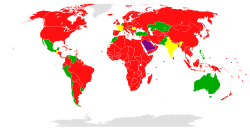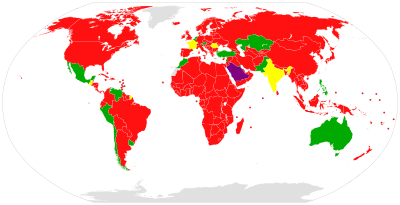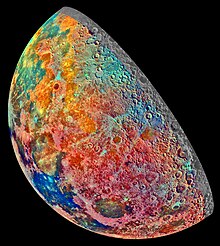Moon Treaty
From Wikipedia, the free encyclopedia
Moon Treaty
Long name:[show]
Ratifications and signatories of the treaty
Parties
Signatories
Non-parties
Signed December 18, 1979
Location New York, USA
Effective July 11, 1984
Condition 5 ratifications
Signatories 11[1]
Depositary Secretary-General of the United Nations
Languages English, French, Russian, Spanish, Arabic and Chinese
International ownership treaties
Moon Treaty
The Agreement Governing the Activities of States on the Moon and Other Celestial Bodies,[3][4] better known as the Moon Treaty or Moon Agreement, is a multilateral treaty that turns jurisdiction of all celestial bodies (including the orbits around such bodies) over to the participant countries. Thus, all activities would conform to international law, including the United Nations Charter.
It has not been ratified by any state that engages in self-launched human spaceflight or has plans to do so (e.g. the United States, the larger part of the member states of the European Space Agency, Russia (former Soviet Union), People's Republic of China and Japan) since its creation in 1979, and thus it has little to no relevancy in international law.[5] As of January 2019, 18 states are parties to the treaty.[1]
Contents
History[edit]
After the 1967 non-armament Outer Space Treaty was signed, it was followed in 1968 with the United Nations convened UNISPACE, the United Nations Conference on the Exploration and Peaceful Uses of Outer Space. It was the first of a series of UN-sponsored conferences intended to create an international framework of laws to guide humanity's use of outer space resources.[6] However, the efforts failed.[7]
After ten more years of negotiations, the Moon Treaty was created in 1979 as a framework of laws to develop a regime of detailed procedures, and as such, it remained imprecise: its Article 11.5 states that the exploitation of the natural shall be governed by an international regime that would establish the appropriate procedures. In order to define this regime or laws, a series of UN-sponsored conferences took place, but brought no consensus. The continuing disagreement is based mainly over the meaning of "Common Heritage of Mankind" and on the rights of each country to the natural resources of the Moon.[6]
On July 29 and 31, 1980, the Subcommittee on Science, Technology and Space, which was a part of the Senate Committee on Commerce, Science and Transportation held hearings on the Moon Treaty. S. Neil Hosenball was one of the supporters of the treaty, and he attempted to compare the Moon Treaty to mining rights within the United States. Hosenball was unsuccessful in his attempt to convince the committee that the United States should ratify the Moon Treaty. The opposition, led by Leigh Ratiner of the L-5 Society, stated that the Moon Treaty was opposed to free enterprise and private property rights. Ratiner provided a potential solution to the Moon Treaty, and suggested that there should be legal claims to the Moon and "there should be a system to register such claims. By the way, I'm not speaking of claims to territory...I don't think it's necessary for us to deal with the issue of whether one can make a claim to the land itself, as long as one has the exclusive right to use it."[8]
The last effort culminated in June 2018 after eight years of negotiations,[7] when the United Nations Committee on the Peaceful Uses of Outer Space (COPUOS) held a high-level meeting that tried to produce a consensus on a framework of laws for the sustainable development of outer space, but it also failed to do so[7] when S. Neil Hosenball, who is the NASA General Counsel and chief US negotiator for the Moon Treaty, decided that negotiation of the rules of the international regime should be delayed until the feasibility of exploitation of lunar resources has been established.[9]
If rights to economic benefits cannot be guaranteed, there will be little if any private investment.[10] So seeking clearer regulatory conditions and guidelines,[11] private companies in the US prompted the US government and legalized space mining in 2015 by introducing the US Commercial Space Launch Competitiveness Act of 2015.[12] Similar national legislations legalizing extraterrestrial appropriation of resources are now being replicated by other nations, including Luxembourg, Japan, China, India and Russia.[13] While the "national" treaty explicitly allows commercial mining, other experts argue that these new national laws are inconsistent with the Moon Treaty and customary international law.[13][14][15][16] Other experts affirm that the Moon Treaty does allow commercial mining, after creating the needed international regulations.[7] This has created a controversy on claims and on mining rights for profit.[16][11][7]
Objective[edit]
It was noted that since the 1967 Outer Space Treaty was signed, technologies and society evolved, requiring a redefinition of the rights and responsibilities of citizens and governments alike in the use and development of outer space.[6] The primary stated objective of the 1979 Moon Treaty is "to provide the necessary legal principles for governing the behavior of states, international organizations, and individuals who explore celestial bodies other than Earth, as well as administration of the resources that exploration may yield."[6] It proposed to do so by having the state parties produce an "international regime" that would establish the appropriate procedures (Article 11.5).[6][7]
Ratification[edit]
Participation in the Moon Treaty
Parties
Signatories
Non-parties
The treaty was finalized in 1979 and, after satisfying the condition requiring 5 ratifying states, it entered into force for the ratifying parties in 1984. As of January 2019, 18 states are parties to the treaty,[1] seven of which ratified the agreement and the rest acceded.[1][17] Four additional states have signed but not ratified the treaty.[1][17] The L5 Society and others successfully opposed ratification of the treaty by the United States Senate.[18][19]
Provisions[edit]
The Moon Treaty proposes to establish an "international regime" or "framework of laws" that apply to the Moon and to other celestial bodies within the Solar System, including orbits around or other trajectories to or around them.[3][7]
The Moon Treaty lays several provisions outlined in 21 articles.[3] In Article 1, the treaty makes a declaration that the Moon should be used for the benefit of all states and all peoples of the international community.[20] It reiterates that lunar resources are "not subject to national appropriation by claim of sovereignty, by means of use or occupation, or by any other means."[20] It also expresses a desire to prevent the Moon from becoming a source of international conflict, so that the resources should be used exclusively for peaceful purposes. To those ends, the treaty lays several provisions, and some of these are paraphrased below:[3]
An artificially colored mosaic constructed from a series of 53 images taken through three spectral filters by Galileo's imaging system as the spacecraft flew over the northern regions of the Moon on 7 December 1992. The colors indicate different materials.
Bans any military use of celestial bodies, including weapon testing, nuclear weapons in orbit, or military bases. The use of military personnel for scientific research or for any other peaceful purposes shall not be prohibited. (Article 3.4)
Provides a framework of laws to establish an international cooperation regime, including appropriate procedures, to govern the responsible exploitation of natural resources of the Moon. (Article 11.5)[21]
Bans altering the environmental balance of celestial bodies and requires that states take measures to prevent accidental contamination of the environments of celestial bodies, including Earth. (Article 7.1)
The orderly and safe use of the natural lunar resources with an equitable sharing by all state parties in the benefits derived from those resources. (Article 11.7)
The placement of personnel or equipment on or below the surface shall not create a right of ownership. (Article 11)
There shall be freedom of scientific research and exploration and use on the Moon by any party without discrimination of any kind. (Article 6) Samples obtained during research activities, are hoped to be made available to all countries and scientific communities for research. (Article 6.2)
Any areas or regions reported to have a special scientific interest, shall be designated as international scientific preserves. (Article 7.3)
Shall promptly inform the United Nations and the public of any phenomena which could endanger human life or health, as well as of any indication of extraterrestrial life. (Article 5.3)
State parties shall ensure that non-governmental entities under their jurisdiction shall engage in activities on the Moon only under the authority and continuing supervision of the appropriate state party. (Article 14)
All parties shall inform the United Nations as well as the public, of their activities concerned with the exploration and use of the Moon. (Article 5)
Any state party to this agreement may propose amendments to the agreement. (Article 17)
When compared with the Outer Space Treaty, it reiterates most provisions, and adds two new concepts in order to address the exploitation of natural resources in outer space: to apply the concept of 'common heritage of mankind' to outer space activities, and to have the participating countries produce a regime that lays the appropriate procedures for orderly mining.[6] Multiple conferences produced no consensus on these two items.
Legal status[edit]
The current imprecision of the agreement generated various interpretations,[20][22] and it is cited as the main reason it was not ratified by most parties.[22][23] The agreement was ratified by few countries, which has been described as a failure [19] and without fruition.[6] Only one country (India) with independent spaceflight capabilities has signed (but not ratified) the treaty. An expert in space law and economics thinks that the treaty would need to offer adequate provisions against any one company acquiring a monopoly position in the world minerals market, while avoiding "the socialization of the Moon."[24] Another expert commends the treaty as a germinal legal framework for developing the needed laws, rather than a finished set of detailed laws.[25]
While the treaty reiterates the prohibition of sovereignty of "any part" of space, it proposes that the exploitation of resources shall be governed by an international regime (Article 11.5), but there has been no consensus establishing these laws.[22] S. Neil Hosenball, who is the NASA General Counsel and chief US negotiator for the Moon Treaty, decided in 2018 that negotiation of the rules of this international regime should be delayed until the feasibility of exploitation of lunar resources has been established.[9] A legal expert stated in 2011 that the international issues "would probably be settled during the normal course of space exploration."[6]
In 2020, U.S. President Donald Trump signed an executive order called "Encouraging International Support for the Recovery and Use of Space Resources." The order emphasizes that "the United States does not view outer space as a 'global commons" and calls the Moon Agreement a "a failed attempt at constraining free enterprise."[26][27]
List of parties[edit]
 Australia 7 Jul 1986 Accession
Australia 7 Jul 1986 Accession Austria 21 May 1980 11 Jun 1984 Ratification
Austria 21 May 1980 11 Jun 1984 Ratification Belgium 29 Jun 2004 Accession
Belgium 29 Jun 2004 Accession Chile 3 Jan 1980 12 Nov 1981 Ratification
Chile 3 Jan 1980 12 Nov 1981 Ratification Kazakhstan 11 Jan 2001 Accession
Kazakhstan 11 Jan 2001 Accession Kuwait 28 Apr 2014 Accession
Kuwait 28 Apr 2014 Accession Lebanon 12 Apr 2006 Accession
Lebanon 12 Apr 2006 Accession Mexico 11 Oct 1991 Accession
Mexico 11 Oct 1991 Accession Morocco 25 Jul 1980 21 Jan 1993 Ratification
Morocco 25 Jul 1980 21 Jan 1993 Ratification Netherlands 27 Jan 1981 17 Feb 1983 Ratification
Netherlands 27 Jan 1981 17 Feb 1983 Ratification Pakistan 27 Feb 1986 Accession
Pakistan 27 Feb 1986 Accession Peru 23 Jun 1981 23 Nov 2005 Ratification
Peru 23 Jun 1981 23 Nov 2005 Ratification Philippines 23 Apr 1980 26 May 1981 Ratification
Philippines 23 Apr 1980 26 May 1981 Ratification Saudi Arabia 18 Jul 2012 Accession
Saudi Arabia 18 Jul 2012 Accession Uruguay 1 Jun 1981 9 Nov 1981 Ratification
Uruguay 1 Jun 1981 9 Nov 1981 Ratification Venezuela 3 Nov 2016 Accession
Venezuela 3 Nov 2016 AccessionList of signatories[edit]
 Guatemala 20 Nov 1980
Guatemala 20 Nov 1980 India 18 Jan 1982
India 18 Jan 1982 Romania 17 Apr 1980
Romania 17 Apr 1980Moon (Moon Treaty)
See also International organization
See also[edit]
International ownership treaties
Moon Treaty
References[edit]
^ Jump up to:a b c d e f g h "Agreement governing the Activities of States on the Moon and Other Celestial Bodies". United Nations. Retrieved 2014-12-05.
^ Jump up to:a b c "Agreement Governing the Activities of States on the Moon and Other Celestial Bodies". United Nations Office for Disarmament Affairs. Retrieved 2013-05-16.
^ Jump up to:a b c d Agreement Governing the Activities of States on the Moon and Other Celestial Bodies. - Resolution 34/68 Adopted by the General Assembly. 89th plenary meeting; 5 December 1979.
^ Agreement Governing the Activities of States on the Moon and Other Celestial Bodies, Dec. 5, 1979, 1363 U.N.T.S. 3
^ "Institutional Framework for the Province of all Mankind: Lessons from the International Seabed Authority for the Governance of Commercial Space Mining.] Jonathan Sydney Koch. "Institutional Framework for the Province of all Mankind: Lessons from the International Seabed Authority for the Governance of Commercial Space Mining." Astropolitics, 16:1, 1-27, 2008. doi:10.1080/14777622.2017.1381824
^ Jump up to:a b c d e f g h Regulation of the Outer Space Environment Through International Accord: The 1979 Moon Treaty. James R. Wilson. Fordham Environmental Law Review, Volume 2, Number 2, Article 1, 2011.
^ Jump up to:a b c d e f g Beyond UNISPACE: It's time for the Moon Treaty. Dennis C. O'Brien. Pace Review. 21 January 2019. Quote 1: "The Moon Treaty acknowledges a role for private enterprise as 'non-governmental' entities. Although it requires all private activities in space to be under the 'supervision and control' of their country of origin, it does not specify any further regulations. Rather, it leaves it up to the 'Member States'—those nations who have adopted the treaty—to create a framework of laws to facilitate the 'safe and orderly' commercial use of space resources, at such time when such regulations become necessary"; "Quote 2: "It is worth repeating that the Moon Treaty does not mandate any specific regulation for space commerce, but does require countries to create such regulations as the need arises."
^ U.S. Congress. Senate, Subcommittee on Science, Technology, and Space of the Committee of Commerce, Science, and Transportation. Hearings before Subcommittee on Science, Technology, and Space of the Committee of Commerce, Science, and Transportation, 96th Congress, 2nd sess., 1980.
^ Jump up to:a b Beldavs, Vidvuds (15 January 2018). "Simply fix the Moon Treaty". The Space Review.
^ O'Brien, Dennis (5 March 2018). "Why it's a bad idea to weaken the Moon Treaty". Space Review. […] the Moon Treaty, must be revised so that investors in a future space economy can achieve a sustainable return on their investments.
^ Jump up to:a b Why it's a bad idea to weaken the Moon Treaty. Dennis O'Brien, The Space Review. 5 March 2018. Quote: "Its not really so much what the regulation is but that there is regulatory clarity. Right now, because there are no clear regulations on these activities, companies are afraid, […]"
^ H.R.2262 - U.S. Commercial Space Launch Competitiveness Act. 114th Congress (2015-2016). Sponsor: Rep. McCarthy, Kevin. 5 December 2015.
^ Jump up to:a b If space is 'the province of mankind', who owns its resources? Senjuti Mallick and Rajeswari Pillai Rajagopalan. The Observer Research Foundation. 24 January 2019.
^ Ridderhof, R. (18 December 2015). "Space Mining and (U.S.) Space Law". Peace Palace Library. Retrieved 26 February 2019.
^ "Law Provides New Regulatory Framework for Space Commerce | RegBlog". www.regblog.org. Retrieved 2016-03-28.
^ Jump up to:a b Davies, Rob (6 February 2016). "Asteroid mining could be space's new frontier: the problem is doing it legally". The Guardian.
^ Jump up to:a b Status of international agreements relating to activities in outer space as at 1 January 2008 United Nations Office for Outer Space Affairs, 2008
^ Chapter 5: O'Neills Children Archived 2016-12-10 at the Wayback Machine, Reaching for the High Frontier, The American Pro-Space Movement 1972-84, by Michael A. G. Michaud, National Space Society.
^ Jump up to:a b Listner, Michael (24 October 2011). "The Moon Treaty: failed international law or waiting in the shadows?". The Space Review. 9 October 2015.
^ Jump up to:a b c Schingler, J. K.; Kapoglou, A. (July 15–17, 2019). "Common Pool Lunar Resources" (PDF). Lunar ISRU 2019: Developing a New Space Economy Through Lunar Resources and Their Utilization. Columbia, Maryland.
^ Moon Agreement, Article 11.5 quote: "5. States Parties to this Agreement hereby undertake to establish an international regime, including appropriate procedures, to govern the exploitation of the natural resources of the moon as such exploitation is about to become feasible. This provision shall be implemented in accordance with article 18 of this Agreement."
^ Jump up to:a b c Current International Legal Framework Applicability to Space Resource Activities. Fabio Tronchetti, IISL/ECSL Space Law Symposium 2017, Vienna 27 March 2017.
^ Extraterrestrial Property and Space Law: Frequently Asked Questions. Moon Estates. Accessed on 6 November 2019.
^ The Moon Agreement and Private Enterprise: Lessons from Investment Law.Timothy G. Nelson. ILSA Journal of International & Comparative Law. Vol: 17, No. 2. (2010)
^ The 1979 Moon Agreement. Louis de Gouyon Matignon, Space Legal Issues. 17 July 2019.
^ Administration Statement on Executive Order on Encouraging International Support for the Recovery and Use of Space Resources
^ "Reference: C.N.124.2012.TREATIES-2 (Depositary Notification)" (PDF). New York, NY: United Nations. Retrieved 2012-04-03.
External links[edit]
 Works related to Moon Treaty at Wikisource
Works related to Moon Treaty at WikisourceInternational Institute of Space Law - promotes the expansion of the rule of law for the peaceful use of outer space.
Treaty Text — "Agreement Governing The Activities Of States On the Moon And Other Celestial Bodies" (1979)
Official Treaty Site — United Nations Office for Outer Space Affairs (UNOOSA), including versions of the treaty in several languages: Arabic, Chinese, English, French, Russian, and Spanish.








